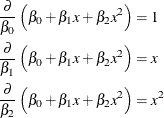The NLIN Procedure
- Overview
-
Getting Started

-
Syntax

-
Details
 Automatic DerivativesMeasures of Nonlinearity, Diagnostics and InferenceMissing ValuesSpecial VariablesTroubleshootingComputational MethodsOutput Data SetsConfidence IntervalsCovariance Matrix of Parameter EstimatesConvergence MeasuresDisplayed OutputIncompatibilities with SAS 6.11 and Earlier Versions of PROC NLINODS Table NamesODS Graphics
Automatic DerivativesMeasures of Nonlinearity, Diagnostics and InferenceMissing ValuesSpecial VariablesTroubleshootingComputational MethodsOutput Data SetsConfidence IntervalsCovariance Matrix of Parameter EstimatesConvergence MeasuresDisplayed OutputIncompatibilities with SAS 6.11 and Earlier Versions of PROC NLINODS Table NamesODS Graphics -
Examples

- References
The NLIN procedure performs univariate nonlinear regression by using the least squares method. Nonlinear regression analysis is indicated when the functional relationship between the response variable and the predictor variables is nonlinear. Nonlinearity in this context refers to a nonlinear relationship in the parameters. Many linear regression models exhibit a relationship in the regressor (predictor) variables that is not simply a straight line. This does not make the models nonlinear. A model is nonlinear in the parameters if the derivative of the model with respect to a parameter depends on this or other parameters.
Consider, for example the models
![\begin{align*} \mr{E}[Y|x] & = \beta _0 + \beta _1 x \\ \mr{E}[Y|x] & = \beta _0 + \beta _1 x + \beta _2 x^2 \\ \mr{E}[Y|x] & = \beta + x/\alpha \end{align*}](images/statug_nlin0001.png)
In these expressions, ![]() denotes the expected value of the response variable Y at the fixed value of x. (The conditioning on x simply indicates that the predictor variables are assumed to be non-random in models fit by the NLIN procedure. Conditioning
is often omitted for brevity in this chapter.)
denotes the expected value of the response variable Y at the fixed value of x. (The conditioning on x simply indicates that the predictor variables are assumed to be non-random in models fit by the NLIN procedure. Conditioning
is often omitted for brevity in this chapter.)
Only the third model is a nonlinear model. The first model is a simple linear regression. It is linear in the parameters ![]() and
and ![]() since the model derivatives do not depend on unknowns:
since the model derivatives do not depend on unknowns:

The model is also linear in its relationship with x (a straight line). The second model is also linear in the parameters, since

It is a curvilinear model since it exhibits a curved relationship when plotted against x. The third model, finally, is a nonlinear model since

The second of these derivatives depends on a parameter ![]() . A model is nonlinear if it is not linear in at least one parameter.
. A model is nonlinear if it is not linear in at least one parameter.